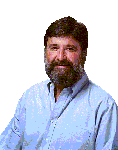
Registered Patent Agent
WebPatent.com
|
You have a great idea. Is patenting the best way to protect it? How much do patents cost? How do you find out if your idea is patentable?
|
|

|
Robert M. Hunter, Ph.D.
Registered Patent Agent WebPatent.com |
| Home | Qualifications | Contact Info | Site Map | Other Links |
REGISTERED PATENT AGENT
PATENTING HIGH-TECH INVENTIONS
This document web presents information on the patenting of high-tech inventions in the U.S. The definition we use for "high-tech" is the same as that used by the U.S. National Science Foundation, which includes the fields of automation, biotechnology, computer hardware, advanced materials, photonics and optics, software, electronic components, telecommunications, chemicals, defense-related, energy, environmental, manufacturing equipment, medical, pharmaceuticals, test and measurement and transportation.
For the most part, patents for high-tech inventions are obtained in the same way and under the same rules that patents for other inventions are obtained. Only in a few high-tech fields does any real controversy exist about specific issues such patentability and adequacy of disclosure. Protecting inventions with patents in the more "controversial" or "unsettled" fields of software, biotechnology and medical procedures are described below.
Software (Computer-Related) Patents
Questions about software (computer-related) patents typically involve patentability ("Can software be patented?") and disclosure ("How should a software invention be described in a patent application?"). In general, the answer to the first question is, "Yes, if it is useful and would have been novel and not obvious to one skilled in the art to which it pertains on the day it was invented, provided the invention is claimed in a way that is acceptable to the patent office." The answer to the second question is, "The invention (whether it be claimed as a product or an a process) must be disclosed in sufficient detail that a person skilled in the art could make and use the invention without undue experimentation, relying only on the disclosure in the patent application as filed and knowledge in the art."
Patent professionals (patent agents and patent attorneys) have written and published on the Web a variety of excellent technical articles on this subject. Some interesting articles are as follows:
Ladas & Parry Guide to Statutory Protection for Computer Software in the United States--This article is posted on the Ladas & Parry website.
The U.S. Patent and Trademark Office (USPTO) has established procedures for examination of patent applications on computer-related inventions in the Manual of Patent Examining Procedure (MPEP). Some of the more relevant MPEP sections are as follows:
MPEP 2106 Patentable Subject Matter--Computer-Related Inventions
MPEP 2106.01 Computer Programming and 35 U.S.C. 112, First Paragraph
U.S. courts have published opinions or decisions (called case law) concerning the patentability of computer-related inventions. Some of the more important court decisions are as follows:
Parker v. Flook, 437 U.S. 584 (1978)
Gottschalk v. Benson, 409 U.S. 63 (1972)
Brenner, Commissioner of Patents v. Manson, 383 U.S. 519 (1966)
Biotechnology Patents
In general, patentability and disclosure questions are also associated with biotechnology patents and the same answers are appropriate. In this situation, too, patentable subject matter may "include any thing under the sun that is made by man."
Patent professionals have written and published on the Web a variety of excellent technical articles on this subject. Some interesting articles are as follows:
Biotechnology and United States Patent Practice--This article is posted on the Ladas & Parry website.
The U.S. Patent and Trademark Office (USPTO) has established procedures for examination of patent applications on biotechnology inventions in the Manual of Patent Examining Procedure (MPEP). Some of the more relevant MPEP sections are as follows:
MPEP 2105 Patentable Subject Matter--Living Subject Matter
MPEP 2402 The Deposit Rules--These rules concern the deposit of the biological materials to which the hypothetical "person skilled in the art" would need to have access to practice the invention.
MPEP 2421.02 Summary of the Requirements of the Sequence Rules--These rules apply to patent applications that contain disclosures of nucleotide or amino acid sequence information.
U.S. courts have published opinions or decisions (called case law) concerning the patentability of computer-related inventions. Some of the more important court decisions are as follows:
Brouwer, In re, 77 F.3d 422, 37 USPQ2d 1663 (Fed. Cir. 1996)
Medical Procedure Patents
Recent legislation has limited the enforceability of certain medical procedure patents in the U.S. At present, in certain situations, valid patents may be obtained on a medical procedure but the owner of the patent is unable to prevent others from practicing the invention.
While the USPTO has not published rules implementing the law and courts have not published decisions related to it, the patent that "started it all" is given below:
U.S. Patent No. 5,080, 111 This patent on a surgical technique for use in cataract surgery provided the political impetus for the amendment of 35 U.S.C. 287.
© 1998-2003 Robert M. Hunter PLLC